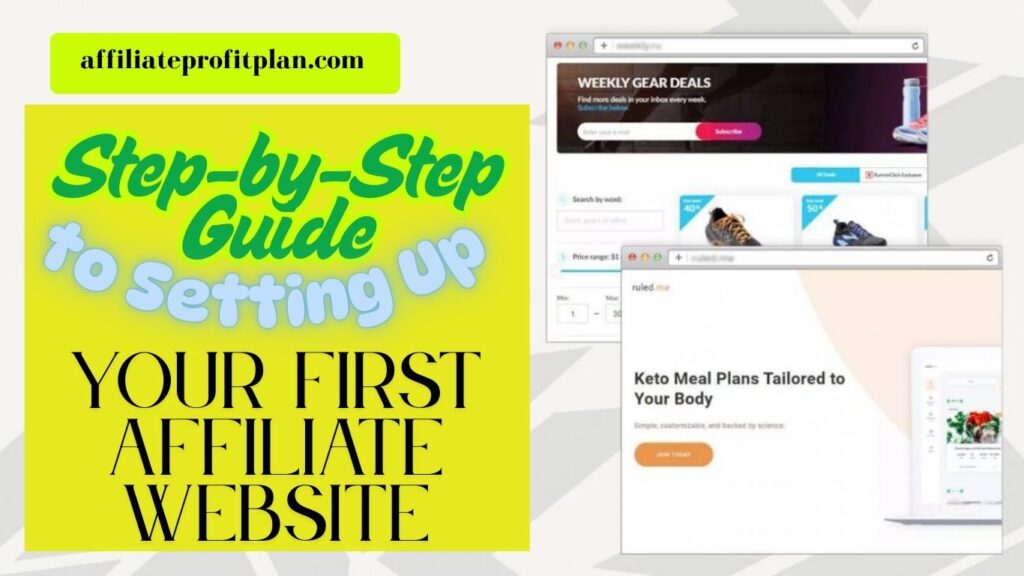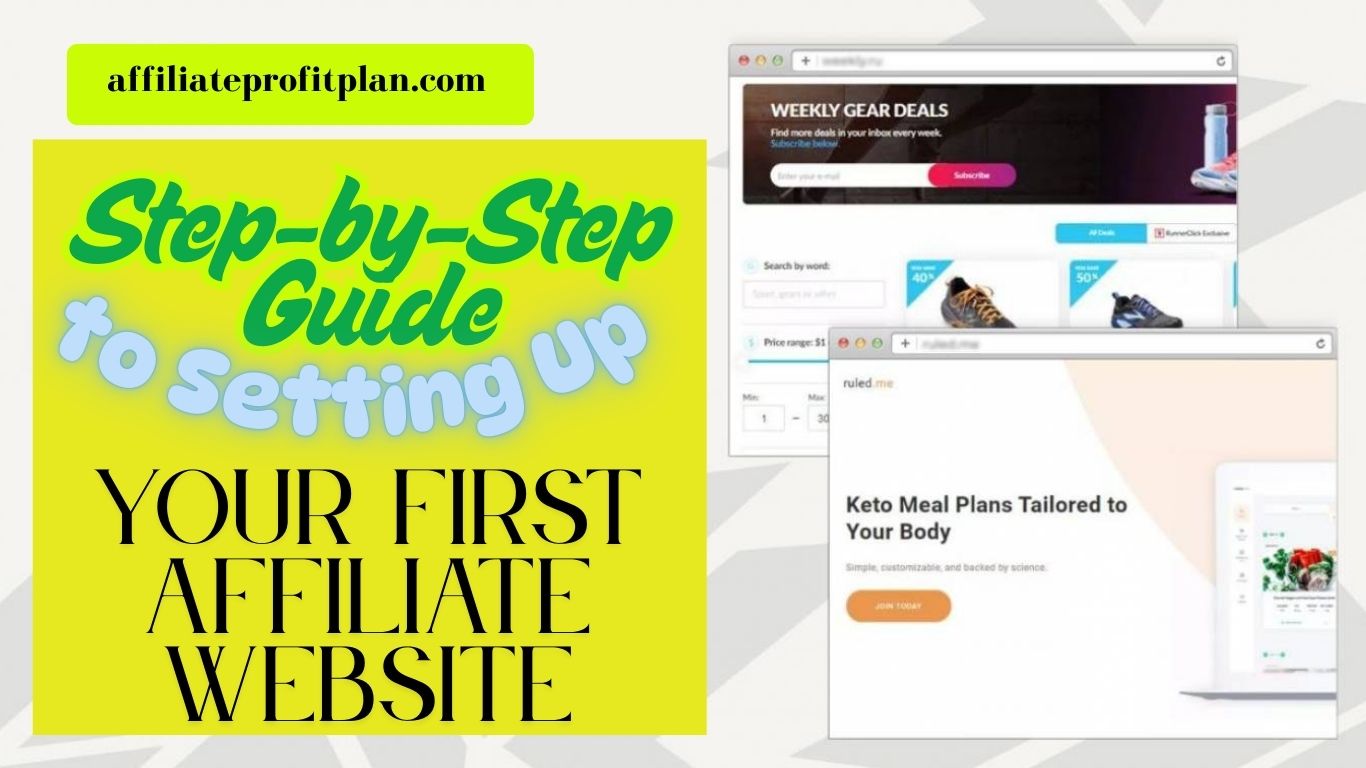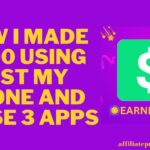Welcome to my article Step-by-Step Guide to Setting Up Your First Affiliate Website. So, you’ve heard about affiliate marketing—the magical world where people make money online while sipping coffee in their pajamas. Sounds too good to be true, right? Well, here’s the thing: it’s 100% real, but it’s not a get-rich-quick scheme. If you’re willing to put in the work, setting up an affiliate website can become a serious source of passive income. The best part? You don’t need to be a tech wizard or a marketing guru to get started. With the right steps, you can have your site up and running in no time.
In this guide, I’ll walk you through the entire process of building your first affiliate website—from picking the perfect niche to launching your site and driving traffic that actually converts. Whether you want to promote fitness products, tech gadgets, or even luxury cat furniture (yes, that’s a thing), this step-by-step tutorial will help you build a profitable affiliate business from scratch. So, grab your favorite drink, get comfy, and let’s dive in! 🚀
Access My Proven Blueprint for $50-$100 Daily Income – Watch This FREE Video Now >>>

Understanding Affiliate Marketing & Choosing a Profitable Niche
Before you dive headfirst into building your affiliate empire, let’s get one thing straight—affiliate marketing isn’t about spamming links and hoping for the best. It’s about recommending products or services that provide real value to your audience. The process is simple: you promote a product, someone clicks your unique affiliate link, makes a purchase, and you earn a commission. Boom! Money in the bank. But here’s the catch—not all niches are created equal.
Choosing the right niche is arguably the most important step in your affiliate marketing journey. Pick a niche that’s too competitive, and you’ll be wrestling with giants. Choose one that’s too obscure, and you might struggle to find an audience. The sweet spot? A niche that’s profitable, has demand, and aligns with your interests (because let’s be honest, writing about something you hate sounds like torture).
Here’s how to find a goldmine niche:
✅ Passion + Profitability – Do you love fitness, tech gadgets, or personal finance? Great! But also check if people are actually spending money in that space. Google Trends, Amazon Best Sellers, and affiliate networks (like ShareASale or CJ Affiliate) are your best friends here.
✅ Competition Check – A little competition is good (it means there’s money to be made), but if the first page of Google is dominated by massive brands, you might want to reconsider.
✅ Endless Content Potential – Can you write blog posts, reviews, and tutorials for this niche long-term? If yes, you’re on the right track!
Once you find your niche, you’re not just setting up a website—you’re building a future money-making machine. Exciting, right? Let’s move on to getting your site set up! 🚀
Setting Up Your Affiliate Website (Domain, Hosting, and CMS)
Alright, now that you’ve picked a niche that’s both profitable and not painfully boring to write about, it’s time to set up your website. This is where things start feeling real—like setting up your virtual storefront, minus the rent and annoying landlords. Don’t worry, you don’t need to be a coding genius or a tech wizard to do this. If you can order a pizza online, you can set up a website.
Step 1: Choosing a Domain Name
Your domain name is your website’s address (like BestTechReviews.com or YogaForBeginners.com). Keep it short, memorable, and niche-relevant—bonus points if it sounds brandable. Avoid weird spellings or long names that look like a WiFi password. Use tools like Namecheap or GoDaddy to check availability.
Step 2: Picking the Right Web Hosting
Think of hosting as your website’s home—it needs to be fast, secure, and reliable (because no one likes a slow site). For beginners, I recommend:
✅ Bluehost – Budget-friendly and beginner-friendly
✅ SiteGround – Great performance and customer support
✅ Cloudways – For those who want speed and scalability
Most hosting providers have a one-click WordPress install, which means no tech headaches. Just click, wait a few seconds, and boom—your website is live!
Step 3: Installing WordPress and Essential Plugins
WordPress is the go-to CMS (Content Management System) for affiliate marketers because it’s easy to use and customizable. After installing it, grab these must-have plugins:
- Yoast SEO or Rank Math – Helps you rank on Google
- WP Rocket or LiteSpeed Cache – Makes your site faster
- UpdraftPlus – Automatic backups (because accidents happen)
And just like that, you’ve built the foundation of your affiliate website. Next up? Making it look good and ready for traffic! 🚀
Designing & Structuring Your Website for Success
Now that your website is officially up and running (yay! 🎉), it’s time to make it look good and function like a pro. A well-designed affiliate website isn’t just about looking pretty—it’s about keeping visitors engaged, guiding them to the right content, and ultimately, getting them to click those affiliate links (aka, your money-makers).
Access My Proven Blueprint for $50-$100 Daily Income – Watch This FREE Video Now >>>
Step 1: Choosing a Clean, Fast, and Mobile-Friendly Theme
Nobody likes a slow, cluttered website. Pick a lightweight and SEO-friendly WordPress theme like Astra, GeneratePress, or Kadence. These themes are fast, easy to customize, and won’t make your site feel like it’s stuck in 2005. Pro tip: Avoid themes with excessive animations and flashy sliders—they slow down your site and annoy visitors.
Step 2: Must-Have Pages for an Affiliate Website
Your website isn’t complete without these essential pages:
✅ Homepage – A clear introduction to your niche and a path to your best content.
✅ About Page – Builds trust with your audience (because people buy from people, not faceless websites).
✅ Blog Page – The heart of your content strategy, where you publish product reviews, comparisons, and tutorials.
✅ Affiliate Disclosure & Privacy Policy – These keep you legally compliant (and yes, they’re required by law).
Step 3: Creating a User-Friendly Navigation & Layout
Ever visited a website that felt like a maze? Don’t be that site. Make sure your menu is simple and easy to navigate—think Home, Blog, Reviews, and Resources. Use clear categories, add a search bar, and structure your homepage with featured posts to guide visitors to the content that matters.
A sleek, well-structured website isn’t just nice to look at—it boosts conversions, keeps visitors around longer, and helps Google love your site. Now, let’s move on to the real magic: creating content that sells! 🚀
Creating High-Quality Content to Attract Traffic & Sales
Alright, your website looks great, it’s easy to navigate, and you’ve got a solid structure. Now comes the part that separates successful affiliate marketers from those who hear crickets—creating content that actually gets traffic and makes sales. Because let’s face it, if no one finds your content, no one’s clicking your affiliate links, and no one’s making you money.
Step 1: Know the Types of Content That Work
Not all content is created equal. Some articles bring in tons of traffic but zero commissions, while others convert like magic. Here’s what works best for affiliate marketing:
✅ Product Reviews – Example: “iPhone 15 Review: Is It Worth the Upgrade?”
✅ Comparison Articles – Example: “MacBook vs. Windows Laptop: Which One Should You Buy?”
✅ Listicles & Roundups – Example: “Top 10 Budget Laptops for Students (2024 Edition)”
✅ How-To Guides & Tutorials – Example: “How to Start a Fitness Blog and Make Money”
Step 2: Master SEO to Rank on Google
If you want free, consistent traffic, SEO (Search Engine Optimization) is your best friend. Here’s how to optimize your content:
- Keyword Research – Use Ahrefs, SEMrush, or Google’s Keyword Planner to find topics people are searching for.
- On-Page SEO – Optimize your titles, meta descriptions, and headers (H1, H2, H3).
- Internal Linking – Connect related posts to keep visitors on your site longer.
- Write for Humans First, Google Second – Engaging, informative, and honest content converts better.
Step 3: Add Affiliate Links Naturally
Nothing screams “spammy” like a blog post stuffed with affiliate links. Place them naturally within your content, recommend products genuinely, and always include a clear call-to-action (CTA) like “Check the latest price here.”
High-quality content isn’t just about ranking—it’s about providing value, building trust, and making sales. Now, let’s talk about how to drive traffic and turn those clicks into commissions! 🚀
Driving Traffic & Monetizing Your Affiliate Website
So, you’ve built your website, picked a killer niche, and created amazing content. Now comes the million-dollar question: How do you get people to actually visit your site and start clicking on those sweet, sweet affiliate links? Because let’s be real—even the best content won’t make money if no one sees it.
Step 1: Mastering Free Traffic Sources
Not all traffic is created equal. You want targeted visitors—people who are actually interested in what you’re promoting. Here’s how to bring them in:
✅ SEO (Search Engine Optimization) – Ranking on Google = Free, long-term traffic. Optimize your posts with keywords, internal links, and quality backlinks.
✅ Pinterest – Yes, it’s more than just recipes and DIY hacks. Create eye-catching pins linking to your content, and watch the traffic roll in.
✅ Social Media (Facebook, Instagram, Twitter, TikTok) – Share your content, engage with your audience, and build a community around your niche.
✅ YouTube – A product review video + an affiliate link in the description = pure gold.
Step 2: Using Paid Ads (If You’re Ready to Invest)
Once you’ve nailed organic traffic, paid ads can help you scale:
- Google Ads – Target people searching for buying-intent keywords (e.g., “Best wireless headphones under $100”).
- Facebook & Instagram Ads – Great for driving traffic to product review pages.
- YouTube Ads – Promote video content that includes your affiliate links.
Step 3: Monetizing Like a Pro
Now, the fun part—turning traffic into commissions:
💰 Strategic Call-to-Actions (CTAs) – “Click here for the best deal” works better than “Buy this now.”
💰 Email Marketing – Build an email list and send valuable content + affiliate recommendations.
💰 A/B Testing – Experiment with different affiliate programs, button placements, and CTAs to see what converts best.
With the right traffic strategies and smart monetization, your affiliate site can become a passive income machine. Now, go get those commissions! 🚀
Conclusion: Your Affiliate Website is Ready—Now Take Action!
Congratulations! 🎉 You’ve just walked through the entire step-by-step process of setting up your first affiliate website—from picking the perfect niche to creating high-converting content and driving traffic like a pro. At this point, your site is no longer just an idea; it’s a money-making machine in the making. But here’s the deal: reading about affiliate marketing won’t make you money—taking action will.
Access My Proven Blueprint for $50-$100 Daily Income – Watch This FREE Video Now >>>
Building a successful affiliate website isn’t an overnight success story. It takes time, effort, and consistency. Your first blog post might not rank instantly, your first affiliate link might not generate sales immediately, and that’s okay! Every successful affiliate marketer started exactly where you are right now. The key is to keep learning, testing, and optimizing.
What’s Next? Keep Growing and Scaling!
✅ Publish Content Regularly – More quality content = more traffic = more sales.
✅ Track Your Performance – Use Google Analytics and affiliate dashboards to see what’s working.
✅ Experiment with Different Affiliate Programs – Sometimes, switching programs can double your commissions.
✅ Never Stop Learning – Stay updated with SEO, content trends, and new affiliate opportunities.
Most importantly, don’t give up. Success in affiliate marketing isn’t about luck—it’s about strategy, patience, and persistence. So go ahead, start creating content, drive that traffic, and watch your first commission roll in. And when that happens? Trust me, it’s one of the best feelings ever.
Now, go build that affiliate empire! 🚀💰
Thanks a lot for reading my article on “ Step-by-Step Guide to Setting Up Your First Affiliate Website” till the end. Hope you’ve helped. See you with another article.










